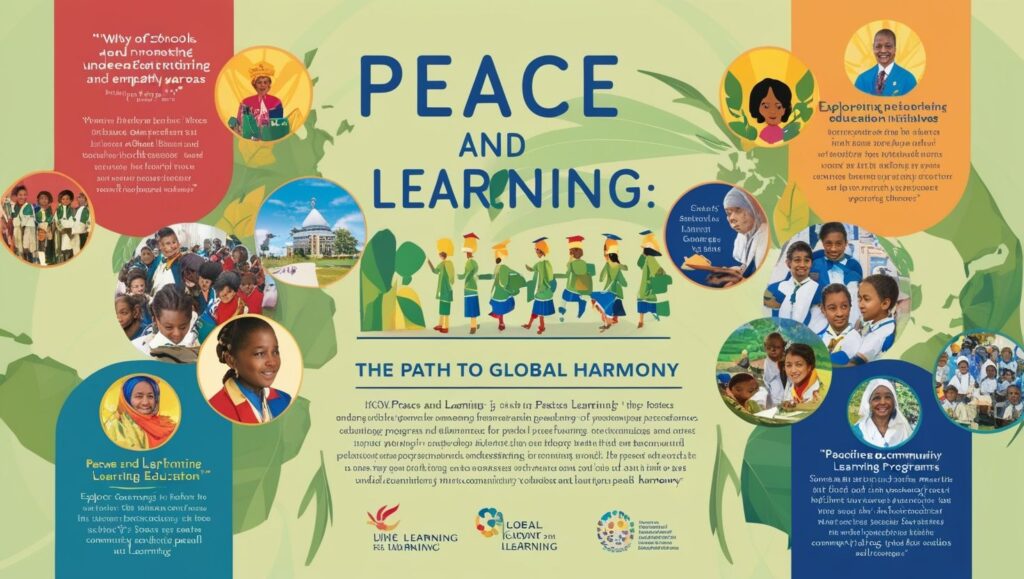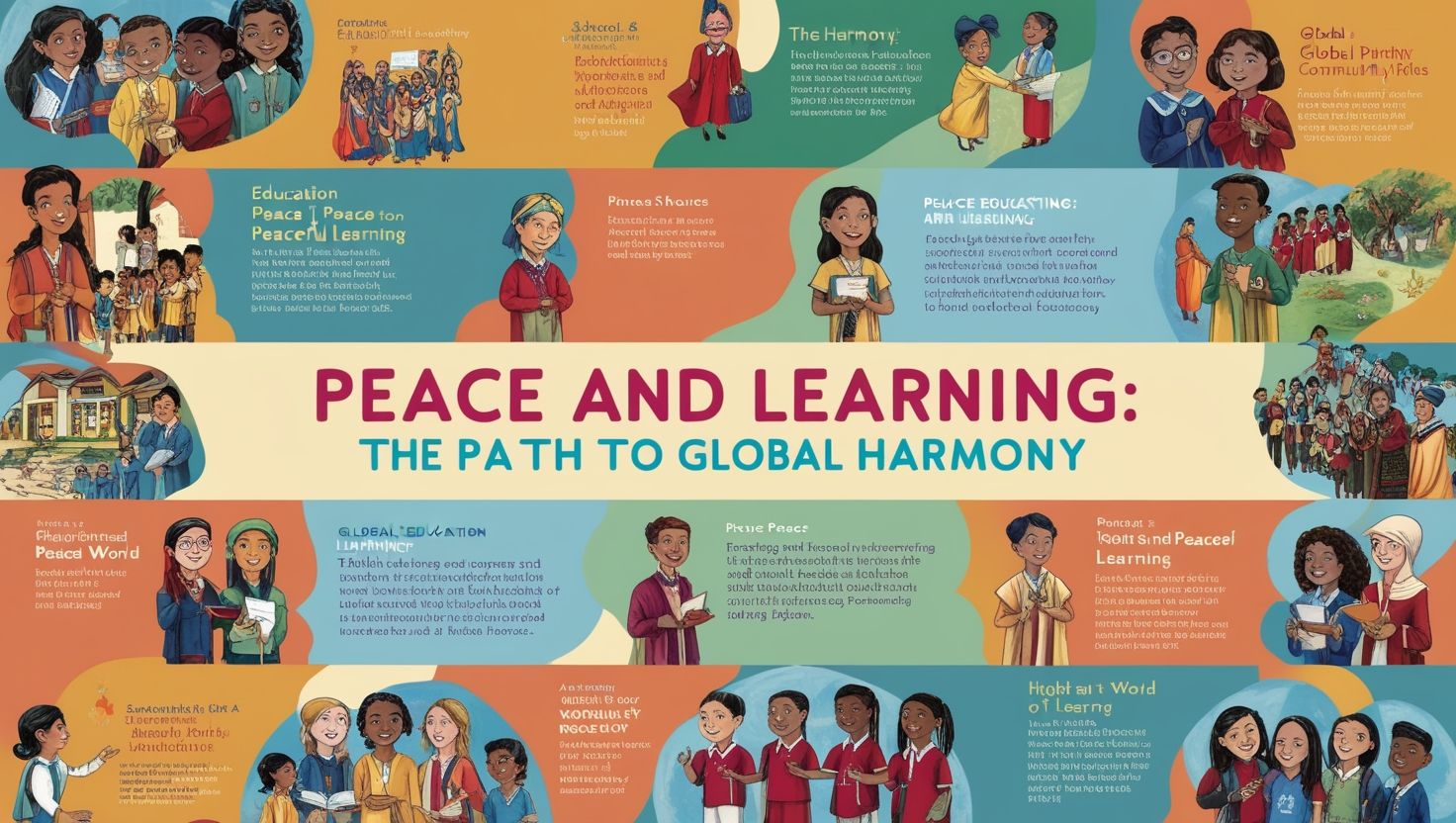Peace and Learning, In the ever-evolving landscape of education, the intersection of peace and learning stands as a critical pillar for nurturing well-rounded, empathetic, and socially responsible individuals. Education, in its truest form, is not just about imparting knowledge or academic skills; it is also about shaping character, instilling values, and fostering a mindset of peaceful coexistence. The relationship between peace and learning transcends the classroom walls, affecting how individuals interact with society and contribute to the broader global community. By integrating principles of peace into the educational system, schools can cultivate not only intellectual growth but also emotional and ethical development.
This article explores the profound connection between peace and learning, the importance of fostering peace in educational settings, and the impact of peace education on students, teachers, and society as a whole. Through this lens, we examine how schools can serve as sanctuaries of peace and learning, and why it is imperative to embed the concept of peace in education to create a more just and compassionate world.
Defining Peace in the Context of Education
Peace in education not limited to the absence of conflict or violence. It encompasses a broader spectrum of promoting positive relationships, cooperation, respect for diversity, and understanding others’ perspectives. A peaceful learning environment is one in which students feel safe, valued, and free from fear—whether it’s fear of failure, discrimination, or harm. Peace in education also involves equipping students with the skills to resolve conflicts, communicate effectively, and engage in critical thinking.
In this context, peace education becomes a proactive process of teaching students how to live in harmony with others, navigate differences constructively, and contribute to a culture of peace in their communities and beyond. It is about fostering a mindset that prioritizes collaboration over competition, empathy over aggression, and dialogue over conflict.
The Role of Peace Education in Schools
Peace education is essential in shaping the next generation of leaders, thinkers, and citizens. It addresses both the immediate environment of the school and the broader societal context in which students live. The goal is not only to create a peaceful atmosphere within the school but also to instill values that students will carry into their adult lives, influencing their behavior as members of a global society.
1. Creating a Safe and Supportive Environment
One of the primary functions of peace education is to create a safe, supportive, and inclusive environment where all students can thrive. A peaceful learning environment ensures that students feel physically and emotionally secure, which is critical for learning to take place. Studies show that when students feel safe, they are more engaged, better able to focus, and more likely to succeed academically.
In peaceful classrooms, teachers model and encourage positive interactions. This can include practices such as conflict resolution, open dialogue, and cooperative learning. When students feel that their voices heard and that they are respected, they are more likely to respect the voices of others, fostering a culture of mutual understanding and respect.
2. Promoting Social and Emotional Learning (SEL)
Social and Emotional Learning (SEL) plays a vital role in peace education by teaching students how to manage their emotions, develop empathy, and build healthy relationships. SEL programs help students recognize and regulate their emotions, which is crucial for resolving conflicts peacefully and interacting with others in a positive manner.
By integrating SEL into the curriculum, schools help students develop the emotional intelligence needed to navigate complex social situations. Students who have strong SEL skills are better equipped to handle disagreements, understand others’ perspectives, and contribute to a peaceful school culture. Moreover, these skills extend beyond the school environment, helping students become more compassionate and thoughtful members of society.
3. Fostering Inclusivity and Respect for Diversity
Peace education promotes inclusivity and teaches students to respect and appreciate diversity in all its forms. In a world that is increasingly interconnected, students need to understand and value different cultures, perspectives, and identities. A peaceful classroom one where diversity is celebrated, and students are encouraged to share their unique backgrounds and experiences.
Inclusion is a key component of peace education. By ensuring that every student feels accepted and valued, schools create an environment where students can learn from one another and develop a deeper understanding of the world. Inclusive education also reduces instances of bullying and discrimination, which are often rooted in fear or misunderstanding of differences. When students learn to embrace diversity, they are less likely to resort to violence or exclusion as responses to conflict.
4. Equipping Students with Conflict Resolution Skills
Conflict is an inevitable part of life, but how individuals handle conflict can make the difference between a peaceful resolution and an escalation into violence. Peace education teaches students effective conflict resolution skills, which are essential for maintaining peaceful relationships and environments.
In a peaceful classroom, students taught how to address conflicts in a constructive manner. This might involve learning to listen actively, communicate openly, and seek win-win solutions. Conflict resolution skills not only help students navigate interpersonal conflicts but also prepare them for resolving larger societal issues in the future.
The Impact of Peace Education on Academic Performance
Peace and learning deeply interconnected. When students learn in a peaceful environment, they are more likely to excel academically. Numerous studies have shown that students perform better when they feel emotionally safe, supported, and connected to their peers and teachers.
1. Reducing Stress and Anxiety
A peaceful learning environment reduces stress and anxiety, which are major barriers to academic success. Students who feel threatened or anxious are less likely to participate in class, ask questions, or engage fully in their learning. By promoting peace in the classroom, teachers can create an atmosphere where students feel comfortable taking risks and making mistakes, which are essential for learning.
2. Encouraging Critical Thinking and Creativity
Peaceful environments encourage critical thinking and creativity, as students are more willing to explore new ideas and challenge themselves when they are not constrained by fear or hostility. In a classroom where students feel respected and valued, they are more likely to engage in creative problem-solving and collaborative learning, which are crucial for academic growth.

3. Improving Teacher-Student Relationships
Peace education also enhances teacher-student relationships, which are fundamental to academic success. When students perceive their teachers as supportive and caring, they more likely to be motivated and engaged in their studies. Positive teacher-student relationships a hallmark of peaceful classrooms, where respect, trust, and open communication are prioritized.
Peace Education and Global Citizenship
One of the long-term goals of peace education is to prepare students for their roles as global citizens. In an increasingly interconnected world, students need to be equipped with the knowledge, skills, and attitudes necessary to contribute to peace on a global scale.
1. Understanding Global Issues
Peace education helps students understand global issues such as poverty, conflict, environmental sustainability, and human rights. By teaching students about these issues, schools can help them develop a sense of responsibility for creating a more just and peaceful world.
2. Encouraging Civic Engagement
Peace education fosters civic engagement by encouraging students to take an active role in their communities and in the world. Students who are taught the values of peace, empathy, and cooperation are more likely to become engaged citizens who work to address social and global challenges. Whether through volunteer work, activism, or simply being informed voters, these students contribute to building a more peaceful society.
3. Promoting Ethical Decision-Making
Ethical decision-making is another critical component of peace education. Students learn to consider the impact of their actions on others and to make choices that promote the well-being of all. This ethical framework is essential for fostering peace at both the local and global levels, as it encourages students to prioritize justice, fairness, and the common good.
Implementing Peace Education: Challenges and Opportunities
While the benefits of peace education are clear, implementing it in schools presents certain challenges. These include resistance to change, limited resources, and the need for teacher training. However, there are also significant opportunities for integrating peace education into existing curricula and school cultures.
1. Teacher Training and Professional Development
Teachers play a crucial role in implementing peace education. Therefore, schools must invest in professional development opportunities that equip teachers with the knowledge and skills to foster a peaceful classroom environment. This might include training in conflict resolution, SEL, and inclusive teaching practices.
2. Integrating Peace Education Across the Curriculum
Peace education does not need to be a standalone subject. It can be integrated into various aspects of the curriculum, from literature and history to science and art. For example, students can learn about historical figures who promoted peace, explore the impact of war on societies, or engage in projects that address social justice issues.
3. Engaging the Wider Community
Schools can also engage the wider community in peace education initiatives. This might involve partnerships with local organizations, parent involvement, or community service projects. By extending peace education beyond the classroom, schools can create a culture of peace that permeates the entire community.
Conclusion
Peace and learning are inseparable. A peaceful learning environment not only fosters academic success but also prepares students to become compassionate, responsible, and engaged citizens of the world. Peace education, with its focus on inclusivity, conflict resolution, and respect for diversity, is essential for creating the conditions in which students can thrive both personally and academically. By integrating peace into the fabric of education, schools can play a vital role in shaping a more harmonious, just, and peaceful future.
References:
- Harris, I. M., & Morrison, M. L. (2012). Peace Education. McFarland & Company.
- UNESCO. (2019). Global Citizenship Education: Preparing Learners for the Challenges of the 21st Century. UNESCO Publishing.
- Goleman, D. (1995). Emotional Intelligence: Why It Can Matter More Than IQ. Bantam Books.
- Salomon, G., & Nevo, B. (2002). Peace Education: The Concept, Principles, and Practices Around the World. Lawrence Erlbaum Associates.
- Reardon

6 thoughts on “Peace and Learning”
Comments are closed.